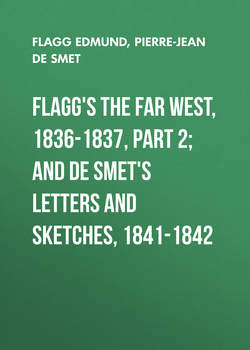Читать книгу Flagg's The Far West, 1836-1837, part 2; and De Smet's Letters and Sketches, 1841-1842 - Flagg Edmund - Страница 10
PREFACE
ОглавлениеTo those who love their country, and their fellow men, we present this interesting Narrative, with the hope, we might say, the certainty, that its perusal will afford them some moments of the purest gratification. We have seldom met any thing more entertaining. Its simple, manly eloquence enchants the attention. The facts it makes known to us of the "far, far West," the dispositions and habits of the Indian Tribes who roam over the vast region of the Oregon, their present state and future prospects, are such as cannot fail to awaken lively interest in all who love to look around them beyond the narrow horizon of every-day scenes, and learn what the holy servants of God are doing for His sake and in His name in distant parts of the world. We have conversed with the apostolic man from whose pen we receive this narrative; and as we listened we felt at once honoured and delighted to be so near one who in our days and in his own person brings before us that lofty spirit of missionary devotedness – those thrilling scenes of Indian life and adventure which we so much admire in the pages of Charlevoix and Bancroft.
Truly our country is full of interest to those who watch its progress, and compare it with the past. Who, for example, could have dreamt that the Iroquois, the savage Mohawk, – under which name we best know the tribe, and whose startling yell so often made our forefathers tremble, – would have been chosen to kindle the first faint sparks of civilization and Christianity among a large portion of the Indian tribes beyond the Rocky Mountains? This is one of the singular facts which these pages present to us. They abound in others not less singular and interesting. Many of these Indian nations actually thirst after the waters of life – sigh for the day when the real "Long Gown" is to appear among them, and even send messengers thousands of miles to hasten his coming. Such longing after God's holy truth, while it shames our colder piety, should also enflame every heart to pray fervently that laborers may be found for this vast vineyard – and open every hand to aid the holy, self-devoted men, who, leaving home and friends and country, have buried themselves in these wilds with their beloved Indians, to live for them and God. One of their favourite plans at this moment is to introduce among them a taste for agriculture, with the means to pursue it. They believe it to be the speediest, perhaps the only way by which the Indians may be won from the wandering life they now in general lead and from the idle habits it engenders. To aid them in this philanthropic object is our sacred duty as men, as Americans, as Christians. It is at least one method of atonement for the countless wrongs which these unfortunate races have received from the whites. We should be grateful to have such an opportunity of doing good: let none suffer the occasion to pass unhonoured by some tribute to the noble cause – some evidence of their love for God, their country and their fellow man.
The frontispiece is from the pencil of one of the Indian Missionaries.
It blends the skill of the artist with the fancy of the poet, and will hardly be understood without a word of explanation. In the foreground we see several of the gigantic trees of the Oregon forests, fallen and crossing each other. On these repose two wolves, a squirrel and several serpents. Above, two Indian chiefs, surnamed in baptism after the great Apostles of the Gentiles, Peter and Paul, are supporting a large basket of hearts, – an offering to heaven from the grateful wilderness. On the right are the emblems of Indian life and warfare: the bow and arrows, battle-axe and shield. Below and above these are seen some of the most remarkable animals of the country – the bear, the wild horse, the badger, the graceful antelope, intermingled with the plover, the pigeon, the wood-cock, the bittern, and other birds of the region. On the left are the peaceful symbols of Christianity – the Bible and the Cross, the chalice and altar lights – the anchor, symbol of faith and hope – the trumpet, to proclaim the word of God and bid the desert bless His holy name. Here too we behold several of the noble animals of the territory – the buffalo, the deer and elk, the mountain sheep and different birds. In the distance are seen on the right, Indian mounds, and a water-spout rising from the river Platte, and on the left, the Rocky Mountains surmounted by the Cross. Festoons, composed of the various flowers the Fathers have met on their way over mountains and prairies and through lonely vallies, complete the picture – the whole supported at the extremities by different birds of the country, and in the centre by the American eagle, – fit emblem, we may say, of their own dauntless faith, as well as of the heroic spirit of the nation within whose borders they have their principal station, and from whose genuine piety they have received the most consoling assurances of final success, viz: the Flat Head Indians and the Pends-d'oreilles, who are styled, even by their foes, the "nation of chiefs."
Once more we earnestly commend the noble cause of these devoted Missionaries to the charity of every sincere Christian. The short time allowed to prepare the work for the press must be our apology for several imperfections or errors which may meet the eye of the reader.
